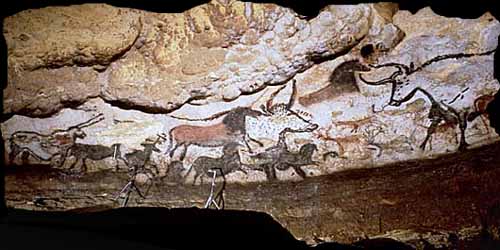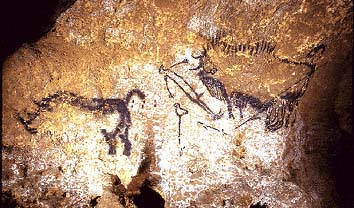Themes: T-Chart Assignment
On the Hunt: The Difference Between Subject and Theme
THEME is not the same as a work’s SUBJECT or TOPIC, which can usually be expressed in a word or two: old age, ambition, love. The THEME is the message, the importance, the meaning, the significance the writer wishes us to discover about that SUBJECT or TOPIC.
Take a look at the image above. The SUBJECT or TOPIC of the seventeen thousand year-old image is the FAUNA or wildlife of the age, but the THEME presented is something quite different, as renowned cultural anthropologist Joseph Campbell relates in his explanation of the hunter/animal COVENANT(binding agreement). Press play to view the video below.
To summarize Campbell, the THEME conveyed here is acknowledgement, acceptance, and celebration of the interconnectedness of living beings...there's a realm of the spirit behind the physical plane, and though certain animals eat other animals, in the end all beings are returned, restored through this spiritual persistance. The physical body may die, but the spirit lives on.
 For this assignment, you are to identify one THEME that hangs on the fence in the background of Wilson's play. You can continue to explore the THEME you used in the last lesson, or identify and develop material for a new theme. Use the ARCHETYPES/UNIVERSAL experiences from the last lesson if you need some ideas. Again, you are not looking simply for terms like love, sacrifice, understanding of self, but trying to determine what the playwright is saying about these terms, subjects, topics.
For this assignment, you are to identify one THEME that hangs on the fence in the background of Wilson's play. You can continue to explore the THEME you used in the last lesson, or identify and develop material for a new theme. Use the ARCHETYPES/UNIVERSAL experiences from the last lesson if you need some ideas. Again, you are not looking simply for terms like love, sacrifice, understanding of self, but trying to determine what the playwright is saying about these terms, subjects, topics.
Find 3–5 passages in the play where a THEME dealing with a topic/subject emerge. Create a T-CHART to analyze what Wilson is trying to say. On the left-hand side of the chart, write the CONCRETE (the passage and page number). On the right-hand side of the chart write COMMENTARY that discusses what you believe Wilson is revealing about the TOPIC/SUBJECT...the THEME.
—AVOID writing a summary of the passage. Commentary includes your thoughts and analysis. Select 3–5 passages to support your THEME.
Click here for an example.
Click here for the blank assignment template.
NEXT: Lesson 3 Language Study: What's up! Idiom, Dialect, Slang
On the Hunt: The Difference Between Subject and Theme
 (http://www.culture.gouv.fr/culture/arcnat/lascaux/img/homeparoi.jpg) Cave Painting from 15,000 B.C Lascaux, France |
THEME is not the same as a work’s SUBJECT or TOPIC, which can usually be expressed in a word or two: old age, ambition, love. The THEME is the message, the importance, the meaning, the significance the writer wishes us to discover about that SUBJECT or TOPIC.
Take a look at the image above. The SUBJECT or TOPIC of the seventeen thousand year-old image is the FAUNA or wildlife of the age, but the THEME presented is something quite different, as renowned cultural anthropologist Joseph Campbell relates in his explanation of the hunter/animal COVENANT(binding agreement). Press play to view the video below.
VIDEO: Excerpt from Joseph Campbell's Power of Myth |
 |
"It is told that Buddha, going out to look on life, was greatly daunted by death. "They all eat one another!" he cried, and called it evil. This process I examined, changed the verb, said, "They all feed one another," and called it good." ~Charlotte Perkins Gilman~ |
 For this assignment, you are to identify one THEME that hangs on the fence in the background of Wilson's play. You can continue to explore the THEME you used in the last lesson, or identify and develop material for a new theme. Use the ARCHETYPES/UNIVERSAL experiences from the last lesson if you need some ideas. Again, you are not looking simply for terms like love, sacrifice, understanding of self, but trying to determine what the playwright is saying about these terms, subjects, topics.
For this assignment, you are to identify one THEME that hangs on the fence in the background of Wilson's play. You can continue to explore the THEME you used in the last lesson, or identify and develop material for a new theme. Use the ARCHETYPES/UNIVERSAL experiences from the last lesson if you need some ideas. Again, you are not looking simply for terms like love, sacrifice, understanding of self, but trying to determine what the playwright is saying about these terms, subjects, topics.Find 3–5 passages in the play where a THEME dealing with a topic/subject emerge. Create a T-CHART to analyze what Wilson is trying to say. On the left-hand side of the chart, write the CONCRETE (the passage and page number). On the right-hand side of the chart write COMMENTARY that discusses what you believe Wilson is revealing about the TOPIC/SUBJECT...the THEME.
—AVOID writing a summary of the passage. Commentary includes your thoughts and analysis. Select 3–5 passages to support your THEME.
Click here for an example.
Click here for the blank assignment template.
NEXT: Lesson 3 Language Study: What's up! Idiom, Dialect, Slang